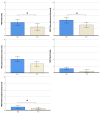Therapeutic communication improves patient comfort during venipuncture in children: a single-blinded intervention study
- PMID: 37330438
- PMCID: PMC10570224
- DOI: 10.1007/s00431-023-05036-7
Therapeutic communication improves patient comfort during venipuncture in children: a single-blinded intervention study
Abstract
The aim of this study was to examine whether therapeutic communication improves children's comfort during venipuncture compared to standard communication. This study was registered in the Dutch trial register (NL8221), December 10, 2019. This single-blinded interventional study was carried out in an outpatient clinic of a tertiary hospital. Inclusion criteria were age between 5 and 18 years, use of topical anesthesia (EMLA) and sufficient understanding of the Dutch language. 105 children were included, 51 assigned to the standard communication group (SC group) and 54 patients to the therapeutic communication group (TC group). The primary outcome measure was self-reported pain based on the Faces Pain Scale Revised (FPS-R). Secondary outcome measures were observed pain (numeric rating scale (NRS)), self-reported/observed anxiety in child and parent (NRS), self-reported satisfaction in child, parent and medical personnel (NRS), and procedural time. No difference was found for self-reported pain. Self-reported and observed anxiety (by parents and medical personnel) was lower in the TC group (p-values ranged from p = 0.005 to p = 0.048). Procedural time was lower in the TC group (p = 0.011). Satisfaction level of medical personnel was higher in the TC group (p = 0.014). Conclusion: TC during venipuncture did not result in lower self-reported pain. However, secondary outcomes (observed pain, anxiety and procedural time) were significantly improved in the TC group. What is Known: • Medical procedures, especially needle related procedures, cause anxiety and fear in children and adults. • In adults communication techniques based on hypnosis are effective in reducing pain and anxiety during medical procedures. What is New: • Our study found that with a small change in communication technique (called therapeutic communication or TC), the comfort of children during venipuncture improves. • This improved comfort was mainly reflected by reduced anxiety scores and shorter procedural time. This makes TC suitable for the outpatient setting.
Keywords: Anxiety; Neurodivergent; Pain; Parental anxiety; Patient comfort; Therapeutic communication; Venipuncture.
© 2023. The Author(s).
Conflict of interest statement
The authors have no relevant financial or non-financial interests to disclose.
Figures






Similar articles
-
Psychological interventions for needle-related procedural pain and distress in children and adolescents.Cochrane Database Syst Rev. 2018 Oct 4;10(10):CD005179. doi: 10.1002/14651858.CD005179.pub4. Cochrane Database Syst Rev. 2018. PMID: 30284240 Free PMC article.
-
Effects of an Immersive Virtual Reality Intervention on Pain and Anxiety Among Pediatric Patients Undergoing Venipuncture: A Randomized Clinical Trial.JAMA Netw Open. 2023 Feb 1;6(2):e230001. doi: 10.1001/jamanetworkopen.2023.0001. JAMA Netw Open. 2023. PMID: 36795410 Free PMC article. Clinical Trial.
-
Comparison of Children's Venipuncture Fear and Pain: Randomized Controlled Trial of EMLA® and J-Tip Needleless Injection System®.J Pediatr Nurs. 2017 Nov-Dec;37:91-96. doi: 10.1016/j.pedn.2017.08.025. Epub 2017 Aug 18. J Pediatr Nurs. 2017. PMID: 28823623 Clinical Trial.
-
Comparison of the effectiveness of three different methods in decreasing pain during venipuncture in children: ball squeezing, balloon inflating and distraction cards.J Clin Nurs. 2016 Aug;25(15-16):2328-35. doi: 10.1111/jocn.13321. Epub 2016 Apr 26. J Clin Nurs. 2016. PMID: 27112434 Clinical Trial.
-
Parent-mediated interventions for promoting communication and language development in young children with Down syndrome.Cochrane Database Syst Rev. 2018 Oct 15;10(10):CD012089. doi: 10.1002/14651858.CD012089.pub2. Cochrane Database Syst Rev. 2018. PMID: 30321454 Free PMC article. Review.
References
-
- Dumoulin S, Bouchard S, Ellis J, Lavoie KL, Vézina M-P, Charbonneau P, Tardif J, Hajjar A. A randomized controlled trial on the use of virtual reality for needle-related procedures in children and adolescents in the emergency department. Games Healt J. 2019;8:285–293. doi: 10.1089/g4h.2018.0111. - DOI - PubMed
Publication types
MeSH terms
Grants and funding
LinkOut - more resources
Full Text Sources
Miscellaneous

